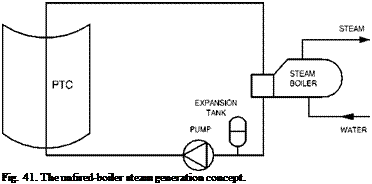Solar thermal collectors and applications
Solar desalination systems
|
Fig. 41. The unfired-boiler steam generation concept. |
 |
Water is one of the most abundant resources on earth, covering three-fourths of the planet’s surface. About 97% of the earth’s water is salt water in the oceans; 3% of all fresh water is in ground water, lakes and rivers, which supply most of human and animal needs. Water is essential to life. The importance of supplying potable water can hardly be overstressed. Man has been dependent on rivers, lakes and underground water reservoirs for fresh water requirements in domestic life, agriculture and industry. However, rapid
industrial growth and the population explosion all over the world have resulted in a large escalation of demand for fresh water. Added to this is the problem of pollution of rivers and lakes by industrial wastes and the large amounts of sewage discharged. On a global scale, manmade pollution of natural sources of water is becoming the single largest cause for fresh water shortage [17]. The only nearly inexhaustible sources of water are the oceans. Their main drawback, however, is their high salinity. It would be attractive to tackle the water-shortage problem with desalination of this water.
Desalination can be achieved by using a number of techniques. These may be classified into the following categories:
(i) phase-change or thermal processes; and
(ii) membrane or single-phase processes.
In Table 11, the most important technologies in use are listed. In the phase-change or thermal processes, the distillation of sea water is achieved by utilising a thermal energy source. The thermal energy may be obtained from a conventional fossil-fuel source, nuclear energy or from a non-conventional solar energy source. In the membrane processes, electricity is used either for driving high pressure pumps or for ionisation of salts contained in the sea water.
Desalination processes require significant quantities of energy to achieve separation. This is highly significant as it is a recurrent cost which few of the water-short areas of the world can afford. Many countries in the Middle East, because of oil income, have enough money to invest and run desalination equipment. People in many other areas of the world have neither the cash nor the oil resources to allow them to develop in a similar manner. It is estimated that the installed capacity of desalinated water systems in year 2000 is about 25 million m3/day, which is expected to increase drastically in the next decades. The dramatic increase in desalinated water supply will create a series of problems, the most significant of which are those related to energy
|
Desalination processes
|
consumption. It has been estimated that the production of 25 million m3/day requires 230 million tons of oil per year. Even if oil were much more widely available, could we afford to burn it on the scale needed to provide everyone with fresh water? Given current understanding of the greenhouse effect and the importance of CO2 levels, this use of oil is debatable. Thus, apart from satisfying the additional energy demand, environmental pollution would be a major concern. Fortunately, there are many parts of the world that are short of water but have exploitable renewable sources of energy that could be used to drive desalination processes.
Solar energy can be used for sea-water desalination either by producing the thermal energy required to drive the phase - change processes or by producing electricity required to drive the membrane processes. Solar desalination systems are thus classified into two categories, i. e. direct and indirect collection systems. As their name implies, direct collection systems use solar energy to produce distillate directly in the solar collector, whereas in indirect collection systems, two sub-systems are employed (one for solar energy collection and one for desalination). Conventional desalination systems are similar to solar systems since the same type of equipment is applied. The prime difference is that in the former, either a conventional boiler is used to provide the required heat or mains electricity is used to provide the required electric power, whereas in the latter, solar energy is applied.
A representative example of direct collection systems is the conventional solar still, which uses the greenhouse effect to evaporate salty water. It consists of a basin, in which a constant amount of seawater is enclosed in a veeshaped glass envelope. The sun’s rays pass through the glass roof and are absorbed by the blackened bottom of the basin. As the water is heated, its vapour pressure is increased. The resultant water vapour is condensed on the underside of the roof and runs down into the troughs, which conduct the distilled water to the reservoir. The still acts as a heat trap because the roof is transparent to the incoming sunlight, but it is opaque to the infrared radiation emitted by the hot water (greenhouse effect). The roof encloses all of the vapour, prevents losses and, at the same time, keeps the wind from reaching the salty water and cooling it. The stills require frequent flushing, which is usually done during the night. Flushing is performed to prevent salt precipitation [165]. Design problems encountered with solar stills are brine depth, vapour tightness of the enclosure, distillate leakage, methods of thermal insulation, and cover slope, shape and material [165,166]. A typical still efficiency, defined as the ratio of the energy utilised in vaporising the water in the still to the solar energy incident on the glass cover, is 35% (maximum) and daily still production is about 34 l/m2 [167]. The interested readers can find more details and a survey of indirect systems in Ref. [18]. For these systems a number of collectors ranging from stationary to low concentration ratio PTC can be used according to the temperature required by the desalination process. The usual temperature that
the thermal desalination evaporators work is around 100 °C. The use of PTC for seawater desalination is described in Ref. [168].